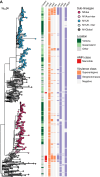Genomic interrogation of invasive group A Streptococcus (iGAS) epidemiology and COVID-19 impacts in Victoria, Australia: a 6-year retrospective study
- PMID: 39944419
- PMCID: PMC11814704
- DOI: 10.1016/j.lanwpc.2025.101467
Genomic interrogation of invasive group A Streptococcus (iGAS) epidemiology and COVID-19 impacts in Victoria, Australia: a 6-year retrospective study
Abstract
Background: Invasive group A Streptococcus (iGAS) cases have increased globally in 2022-2023, raising concerns within the medical and public health communities, including in Australia, while this impact is polyclonal in nature the worldwide spread and dominance of M1UK has been particularly concerning.
Methods: To investigate these changes and prepare to implement routine genomic surveillance of iGAS for public health purposes, we performed whole genome sequencing (WGS) on iGAS isolates from Victoria, Australia between 2017 and 2022. Genomic analyses were conducted to determine the epidemiology, genetic diversity, and population dynamics of iGAS.
Findings: Analysis of 955 confirmed iGAS cases over a 6-year period revealed a polyclonal population. Fewer iGAS cases were noted between 2020 and 2021 in addition to genetic bottlenecks, likely reflecting the implementation of strict public health measures during the COVID pandemic, followed by a resurgence in cases post-COVID. Low levels of antimicrobial resistance were observed, primarily to macrolides and tetracyclines. Phylogenetic analysis identified a previously undescribed emm1 sub-lineage, designated M1Aus, detected in Australia (Victoria and Queensland), Belgium and the United Kingdom. In Victoria, M1Aus was the dominant emm1 variant in 2017 and 2018, more recently replaced by the M1UK lineage as the dominant variant, further demonstrating the worldwide impact of M1UK.
Interpretation: This comprehensive genomic study of iGAS in Victoria, Australia provides valuable insights into the population dynamics, genetic diversity, and impact of pandemic public health measures on iGAS epidemiology. The identification of the M1Aus sub-lineage emphasises the need for continued genomic surveillance and monitoring of iGAS strains, particularly in the context of emerging global sub-lineages and shifts in population structure.
Funding: MDU PHL-Department of Health, Victoria. NHMRC (GNT1196103 to BPH; Partnership Grant GNT1149991).
Keywords: Genomic epidemiology; Invasive group A streptococcus; Streptococcal typing; Streptococcus pneumoniae.
© 2025 The Authors.
Conflict of interest statement
None.
Figures



Similar articles
-
Nationwide upsurge in invasive disease in the context of longitudinal surveillance of carriage and invasive Streptococcus pyogenes 2009-2023, the Netherlands: a molecular epidemiological study.J Clin Microbiol. 2024 Oct 16;62(10):e0076624. doi: 10.1128/jcm.00766-24. Epub 2024 Aug 28. J Clin Microbiol. 2024. PMID: 39194268 Free PMC article.
-
Post-pandemic upsurge in Group A Streptococcus infections at an Italian tertiary university hospital.Microbiol Spectr. 2025 May 6;13(5):e0249424. doi: 10.1128/spectrum.02494-24. Epub 2025 Mar 26. Microbiol Spectr. 2025. PMID: 40135916 Free PMC article.
-
Recent trends in invasive group A Streptococcus disease in Victoria.Commun Dis Intell (2018). 2019 Mar 15;43. doi: 10.33321/cdi.2019.43.8. Commun Dis Intell (2018). 2019. PMID: 30879286
-
Invasive Group A Streptococcal Infections in Europe After the COVID-19 Pandemic.Dtsch Arztebl Int. 2024 Oct 4;121(20):673-680. doi: 10.3238/arztebl.m2024.0127. Dtsch Arztebl Int. 2024. PMID: 38961826 Free PMC article. Review.
-
Chains of misery: surging invasive group A streptococcal disease.Curr Opin Infect Dis. 2024 Dec 1;37(6):485-493. doi: 10.1097/QCO.0000000000001064. Epub 2024 Sep 7. Curr Opin Infect Dis. 2024. PMID: 39259691 Review.
References
-
- Centre for Disease Control and Prevention Antibiotic resistance threats in the United States 2019. 2019. https://www.cdc.gov/DrugResistance/Biggest-Threats.html#groupa Available from:
LinkOut - more resources
Full Text Sources

